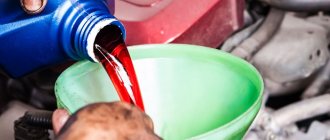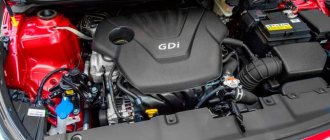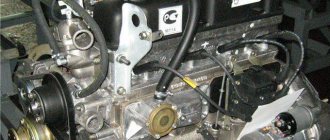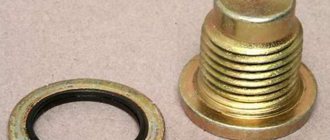Why is it necessary to change the oil?
No matter how trivial the question of changing engine oil may sound, a good third of new car enthusiasts find it difficult. Let's try to figure out why the engine oil is changed.
Engine oil
The main function that any motor fluid performs is, of course, protecting operating mechanisms from premature wear. By enveloping the entire surface of the parts involved, the oil reduces the friction force between them. This function allows you to increase the resource of the motor and extend its service life.
Daily use of a vehicle causes constant temperature changes inside the engine system. Oil “softens” this effect, preventing the working mechanisms from overheating or freezing, but it itself loses its properties over time. The liquid begins to lose viscosity, its structure deteriorates, carbon deposits and soot formed during engine operation contaminate its composition. As a result, fuel and lubricants no longer help the car, but, on the contrary, slowly disable it. Old oil will not be able to provide the required level of anti-corrosion and wear-resistant protection; in addition, a high content of contaminants and deposits on the engine mechanisms will simply complicate their operation. This is why it is so important to change the engine fluid on time.
How often should you change the oil?
And so, let's start with the most interesting thing - changing the engine oil . The instructions (each one is different) recommend changing the oil every 20 - 30,000 km. Agree, this is quite a long gap, and those who have at least once changed the oil themselves could clearly see this. During operation, the oil loses its original properties - its viscosity changes, oxidation processes occur, the so-called detergent-dispersant property deteriorates, due to which the oil, like a sponge, absorbs the products of fuel combustion, keeps them in suspension and does not allow them to settle on the surface details. And modern oils have quite a lot of such properties, and they all gradually deteriorate over time.
So, on average, engine oil remains operational for 10,000 km. Those. During this period of time, all the properties of the oil, all its additives do their job properly. And if you continue to drive beyond these 10 thousand (drive 12-15,000 km), then the properties of the oil will deteriorate to the point that they stop working altogether and begin to cause harm to the engine.
This is why I (and not only me) recommend changing the engine oil every 10,000 km. Or after 250-300 hours of engine operation. This is the approximate time it takes for an average car to achieve this mileage.
As for transmission oil ( box oil ), it is not in such harsh conditions as engine oil, and therefore can be changed much less frequently. Transmission oil, just like motor oil, contains a number of additives that improve its basic functions. And naturally, over time, these additives gradually begin to lose their properties. And since the oil is in a less aggressive environment, unlike motor oil (as I already said), its basic properties remain operational for a longer period of time.
Therefore, it is recommended to change the transmission oil once every 50,000 km. On cars with an automatic transmission, transmission oil ( automatic transmission oil ) is subject to heavy loads and therefore can be changed a little more often - once every 40,000 km.
There are a number of consumables that are best combined into one group and changed all at the same time. What kind of consumables are these? This is an air filter, a cabin filter, spark plugs, and if gas filters are installed, then gas filters.
So, according to the instructions, the air filter must be replaced every 20-30,000 km. The period for replacing spark plugs is approximately the same, maybe a little longer. And now I don’t mean any iridium or platinum spark plugs. I'm talking about the most ordinary candles that are installed by the manufacturer. It is recommended to change the cabin filter and LPG filters every 20-30,000 km. And I think you’ve already guessed where I’m going with this.
A couple of minutes ago I said that, according to the instructions, it is necessary to change the engine oil every 20-30,000 km, but we do this every 10,000. So, based on this, this group of consumables needs to be changed every 10 thousand km. Those. We drove 10 thousand, we change the engine oil and oil filter, of course, we also change the air filter, cabin filter, spark plugs and LPG filters.
Delayed oil change: is it dangerous?
A single violation of the frequency of engine oil changes (within reasonable limits) can go unnoticed by the car. But this does not mean that subsequent repetition of the situation will not lead to serious results. In most cases, failure to observe the interval between oil fluid changes causes:
Changing the engine oil
- formation of a large amount of pollution and deposits. Aging components of the oil fluid gradually begin to break down and leave behind unprocessed combustion products. As a result, the engine loses its former power, and the content of harmful impurities in the exhaust gases increases.
- wear of parts. Oil loses its viscosity over time and begins to leak out of the engine through gaskets and seals. “Defenseless” parts of a working unit begin to rub against each other with great force, increasing the temperature inside the working area and deforming all adjacent structural elements.
On a note! Some categories of oils do not lose, but, on the contrary, increase their viscosity over time. This fact is explained by the excessive oxidation process and impaired polymerization of additives due to incorrect selection of motor oil. High density can make it very difficult to start the engine, prevent effective oil circulation, and also lead to failure of the entire engine system.
- failure of the turbocharger (if equipped) and rotor. Exhausted oil has a detrimental effect on the condition of the compressor shaft and bearings. During prolonged use in “uncomfortable conditions,” severe scratches and cracks appear on them, which significantly reduces their service life. Also, the liquid, which contains a large number of harmful impurities and deposits, clogs the lubrication channels of the compressor unit, which can result in jamming.
The problems described above are not a complete list of possible problems with outdated oil. All cases are individual, but have one main similarity - untimely oil change can result in costly repairs.
Oil change steps
The manufacturer indicates the volume of liquid in the accompanying instructions. But it is recommended to use a dipstick to check the oil level, since the ability to completely drain is not supported by all models. When the engine is warm, the indicators always increase; those who are interested in the question of how to properly change engine oil should also remember this.
Preparation work
The first step is to prepare the necessary equipment for changing the fluid:
- It will be dark under the car, so you can’t do without a flashlight.
- Two keys are also required. Using one, unscrew the drain plug, and with the second, remove the oil filter.
- To collect the waste you will need a separate container. You can use bowls cut into canisters. The main thing is that the product fits under the car and is able to accommodate the entire volume.
- The canister itself contains new oil. You need to take it with a small reserve in volume.
- New filter that suits a specific car.
Replacing the filter
Filters are used to clean liquids from various impurities and particles that make further operation difficult. These parts begin to clog after 8 thousand kilometers. If the replacement is not made in time, the bypass valve opens, which causes a lot of dirt and foreign particles to end up in the engine. There may be no external signals, but in this case premature wear occurs.
Fill the new filter with motor lubricant up to half the volume. There must be a rubber band on the outer body of the device. Then the first launch will be softened.
Engine oil drain procedure
Procedure for draining the oil
The standard procedure for replacing fluids assumes that draining is done as follows:
- The machine is installed on a flat surface. An overpass or inspection hole is the best option. Some people prefer to drive vehicles on top of bricks or other building blocks. Then the front of the car rises, which makes it easier to drain the liquid. But even in this case, the waste will not flow out of the engine completely.
- Setting the handbrake or “parking” mode makes it easier to lock the vehicle in one position. The main thing is that the car does not slide to the side; only in this case the driver’s safety is ensured.
- The drive needs to be warmed up to operating temperature, and then wait a little. This will allow the parts to cool down and the owner to be protected from instant burns.
- Protective panels block access to the oil pan. You also need to get rid of such parts.
- To prevent oil splashing, the collection container must be installed in advance.
- The plug in the engine sump is unscrewed. First, a wrench is used, then the work is done manually. You need to watch the metal or plastic gasket on the plug - it may fall.
- It only takes a few minutes to drain the entire volume of old fluid. If a small part of the waste fluid remains inside, this is normal.
- If there is a lot of sediment in the old oil, then the engine needs to be flushed before adding new material.
- Next comes replacing the oil filter. What is needed to change the oil in an internal combustion engine has already been listed above.
Filling order
The liquid is poured inside after the old oil is completely drained and the filter is replaced. The volume of new material must correspond to what is written in the technical documentation accompanying the car.
Only minor changes in volume are permissible - they will not lead to serious consequences. But overfilling or underfilling can become a problem if it is noticeable. Insufficient oil, for example, often leads to overheating of engines. Strong overflow leads to the fact that the oil seals are squeezed out of the crankshaft.
Is it necessary to change the oil filter?
We figured out why an engine oil change is needed, but why should it be accompanied by a filter change? At first glance, it may seem that this fad is nothing more than a marketing solution to ensure more revenue. But that's not true.
Oil filter
Correctly changing engine oil involves changing the filter. The engine is the center of the car, its heart. It is subject to serious overloads, without which the “life activity” of the car is simply impossible. When temperature “jumps” occur, a small amount of soot forms on the engine, which can cause serious repairs. Oil removes this soot, protecting the engine from contamination. But where does this dirt end up? In the filter.
The oil pumped through the filter is cleaned and again used to “clean up” carbon deposits. But if the oil filter has served its service life and is heavily contaminated, then harmful impurities no longer settle in the safe zone, but accumulate in the lubricant film itself. As a result, the oil quickly becomes obsolete, and the engine system quickly wears out.
It is impossible to check the condition of the old filter, and its contamination can only be assessed after removal. Even if its visual inspection gives reason to believe that it is in working order, it cannot be put back. Let's imagine for a second that you decided to give the filter a second chance and screwed it back in. Once clogged, let’s say, after a couple of thousand kilometers (you won’t even know about it), the filter will stop collecting dirt and will begin to deteriorate the freshly filled oil. As a result, the beneficial properties of the expensive lubricant will instantly disappear, giving way to serious engine malfunctions.
Based on the above facts, the answer to the question posed becomes obvious: the filter must be changed at every oil change.
How to drain engine oil
Even a novice car enthusiast can drain the oil on his own. This work, although dirty, is very simple and does not require special knowledge and skills. In order to drain the oil from the engine, you will need a minimum set of tools and materials:
- a long ring wrench with a 17 - 19 mm head (depending on the size of the plug in the drain hole);
- an old basin, an unnecessary pan or any other container with a volume of at least five liters;
- long rubber gloves;
- hard brush;
- a piece of rag.
Operating procedure.
- The oil must be drained from a hot engine immediately after driving the car. If the engine is cold, start the car and warm the engine to operating temperature at idle speed.
- Drive the car onto an overpass or into a viewing hole in the garage. Turn off the engine and put the car on the handbrake.
- Open the hood. Unscrew the oil filler cap and remove it. Wipe the neck and lid with a rag.
- Take a basin, gloves, wrench, brush and rags and get under the car.
- Use a brush and rag to clean the drain plug located in the oil pan.
- Put on gloves, move the basin closer and start unscrewing the cap with a wrench. Do this very slowly and carefully! The engine oil has a temperature of about 80 o Celsius! If you move carelessly, you can get seriously burned.
- When you feel that the plug is almost out, continue unscrewing it with your right hand, and take a basin in your left hand and bring it under the drain hole.
- After the oil rushes down, gently lower the basin to the floor. If, through carelessness, you dropped a cork into a basin, do not rush to urgently fish it out. Nothing will happen to her. Wait for the oil to cool, and only then remove the plug from the basin. Check to see if the copper gasket has come off.
- Wait until the oil has completely drained from the engine. This takes about twenty minutes.
- After this, wipe the drain bolt and screw it into the neck.
The transmission oil is drained from the gearbox in the same way. The only difference is that the oil in the box is changed much less frequently than in the engine.
Engine fluid change frequency
Checking the oil level
It is impossible to say how often to change the engine oil. The frequency of engine oil changes is unique for each vehicle. And it is installed by vehicle manufacturers. The frequency of engine oil changes is determined not only based on mileage, but also on a time scale.
Take highway and city driving, for example. It would be wrong to focus only on mileage: you will cover 10-15 thousand km along the highway in a shorter period than driving the same distance in city traffic jams. The time scale allows you to prevent oil obsolescence and replace it on time.
By the way, it is worth noting that the more often you pour new lubricant under the hood, the better the car “feels”. Unfortunately, due to the cost of the procedure, not all motorists can afford it. Make it a rule to change the fluid at least once a year.
Important! If you use your car every day, do not skimp on its maintenance and strictly follow the manufacturer's recommendations.
Many car enthusiasts are mistaken in thinking that if the car has not been driven for a long time, then an oil change is not necessary. Even if your vehicle sat in the garage all winter with new (as you thought) oil under the hood, you will have to change it. The fact is that if the engine does not start for a long time, condensation forms in it, which, entering the working mixture, increases the acidity of the environment. Such events contribute to the rapid destruction of structural elements.
Engine oil drain
You can also think about changing the oil after purchasing a used car. Sellers will probably claim that they performed engine maintenance “just last week,” but there is no need to take risks. After draining the old fluid, be sure to flush the entire system. It wouldn’t hurt to ask the previous owner about the company and markings of the oil that was poured under the hood before you.
What do you need to change the oil in an internal combustion engine yourself?
Many car enthusiasts keep their cars outdoors all year round, so they often wonder where to do this and not just dump it on the ground. Drain it into a container and take it to a service station, where they will accept the waste for money. If this is your first time, watch our video of changing the engine oil yourself.
You should have a small container for used oils in your garage. Put the car on the handbrake, find the drain hole. If it is in the center of the crankcase, then unscrew the plug and drain the oil into a 10-liter plastic antifreeze container. It should be closed with a stopper, and cut a hole in the middle of the sidewall and pour oil into it.
It is advisable to drain it after running the internal combustion engine for an hour or two. Only in this case, all unnecessary suspensions collected in the oil will be released. If the car has been sitting in the garage for a week, then all the sludge will remain in the crankcase and mix with clean lubricant.
If there is an inspection hole, you are there; if not, lift the car on both sides on a jack and alternately replace the lift with strong stands for the weight of the car. This will give you a good space to crawl under the crankcase on a mat and drain unnecessary fluid.
During this procedure, fill in new oil and change the filter. Don’t skimp on buying it, remove it, disassemble it, and you’ll see what kind of dirt is packed in there.
DIY bumper: how to make a unique polymer bumper for a car at home (125 photos)Do-it-yourself car painting - preparation for coating and the main stages of high-quality car painting (100 photos)
Polishing a car with your own hands - a step-by-step master class on how and how to polish a car’s paintwork (70 photos)
Should I fill the filter with oil before installing it on the internal combustion engine? From a technological point of view, this does not improve anything, and there will be no air lock in an empty filter. In seconds of engine operation, the oil pump will pump new oil along the entire line and saturate the filter part.
What factors influence replacement frequency?
The frequency of engine oil changes directly depends on the following factors:
- condition of the car. Has your car recently rolled off the production line and is in the running-in stage? This means that its first replacement will be made within the period specified by the manufacturer. Those. approximately 3-5 thousand kilometers. Before the first maintenance, you should refrain from an aggressive driving style (sharp starts, braking, excessive pressure on the gas pedal). All that the car needs during the break-in period is careful gear shifting, smooth pedaling and complete abandonment of sporty driving.
- driving style. By “squeezing” out of the car all the power it is capable of, you are squeezing all the beneficial properties from the oil, which circulates inside the engine at breakneck speed. The more jerky and abrupt your driving habits, the faster the fuel life decreases. Those. Fans of “hot starts” will have to change the engine oil more often. Otherwise, they risk being left without wheels.
Scheme for studying motor oil labels
- fuel quality. The condition of the oil also depends on the quality of gasoline or diesel poured into the fuel tank. A low-quality mixture burns out poorly, leaving behind a large amount of deposits, which eventually mix with the lubricant and clog the engine. It is prohibited to fill up cheap fuel at questionable gas stations.
- chemical basis of the liquid. The frequency of oil changes also depends on its chemical base. Low-quality mineral water needs to be replaced every 5-7 thousand kilometers, semi-synthetics should be updated every 8-9 thousand kilometers, synthetics - 10-15. Such frameworks are established by manufacturers not in order to ensure guaranteed revenue, but in order to maintain the functionality of the entire propulsion system. The more natural ingredients there are in the oil (as, for example, in mineral water), the faster they lose their consumer properties.
- seasonality. If you are a supporter of seasonal oils, then you need to monitor their changes with special care, because you won’t be able to drive with summer lubricant in harsh low-temperature conditions (the engine simply won’t be able to start).
- manufacturer's recommendations. You should not neglect the requirements of the vehicle manufacturer, because the oil change interval indicated in the service book was not set at random, but was calculated based on the results of multi-stage tests.
Why do you need to change the engine oil?
What role does oil play in the power unit, is it important to replace the lubricant, when is this procedure required, work regulations - every vehicle owner should, at least superficially, understand this issue.
When the motor operates, various components and mechanisms move and come into contact with each other. Friction causes increased wear of parts.
Motor oil creates a film on their surface that prevents dry friction. In addition, lubricant helps remove heat from rubbing mechanisms, remove wear products and protect components from corrosion.
All technical fluids, including engine oil, are consumables. Over time, they lose their original properties. To maintain performance and increase the life of the power unit, the lubricant must be changed periodically. Why is it important to do this in a timely manner?
- operation of oil that has lost its performance characteristics leads to increased friction and wear of components and parts;
- both mineral and synthetic lubricating fluids have a certain shelf life, after which they begin to separate into fractions, which leads to a loss of working properties;
- Dirt and carbon deposits gradually accumulate in the lubricant, which over time can begin to settle on the working surfaces of parts, complicating the operation of the system and leading to the destruction of components;
- oil whose service life has expired ceases to protect mechanisms from corrosion, on the contrary, becoming the cause of corrosion phenomena.
Thus, one conclusion can be drawn - failure to replace the lubricant on time can lead to premature failure of the power unit. Major engine repairs are fraught with serious material costs.
Engine oil wear is more difficult to visually determine than, for example, pads or tires. Therefore, you should follow the recommendations of the vehicle manufacturer.
During warranty service, the dealer monitors the schedule of service work; the owner of the equipment is only required to provide the iron horse for maintenance in a timely manner. Otherwise, it may be void of warranty.
After the end of the warranty period, the car owner needs to be more careful (if he refuses the services of a dealer service station) and carry out maintenance, adhering to the recommendations specified in the service book.
Procedure for changing engine oil
Synthetic motor oil
Everything is clear on the theoretical side of the issue, so let’s move on to the practical. The procedure itself is not complicated, the main thing is to be patient and have all the necessary tools.
If your goal is to quickly change the engine oil without flushing, then you should follow the following sequence of actions:
- We place the car on a flat surface, providing unobstructed access to its lower part. The ideal option is a garage with a pit. If there is no such garage, an overpass or a room equipped with lifting mechanisms will do.
Important! The car engine must be maintained at operating temperature. Those. It is better to first drive the vehicle around the city for 30-40 minutes.
- Prepare the container for draining. An old bucket can play its role. It is also recommended to prepare a canister into which the waste liquid will later be poured for disposal.
- Remove the engine protection (if equipped). It is secured with 3-4 bolts.
- Unscrew the oil filler cap, filter and remove the drain plug at the bottom of the vehicle. To dismantle and install the oil filter, it is advisable to use a special wrench with a chain.
On a note! Some plugs are additionally equipped with an O-ring, which is recommended to be changed every time the engine oil is changed.
- After the drain cap is removed, wait until all the old grease drains out. Based on its condition, you can understand how dirty your engine is and whether it is advisable to replace the lubricant.
Some experts recommend washing out any remaining dirt and carbon deposits from the engine by pouring half a liter of new fuel into the oil filler neck.
- Once all the engine oil has drained, we begin installing a new filter. Before screwing it on, it is recommended to lubricate its O-ring. This manipulation will ensure maximum contact of the filter with the propulsion system at the point of its connection.
- Close the drain plug.
- Pour fresh lubricant into the neck. It is difficult to say how much oil you will need. The quantity required for the system is individual for each car. Most often it ranges from 3 to 5 liters. But you cannot overfill the fluid, so constantly check its level with an oil dipstick. The oil should be between the min and max marks. There is no need to immediately pour the required amount of oil into the engine: first reach the min mark, then leave the car alone for 10-15 minutes. During this time, the protective film will be distributed over the working surface and take its usual place. After this procedure, add the required amount of fluid, checking its level with a dipstick.
- Screw on the filler cap and start the engine. For the first few seconds of engine operation, the oil pressure light on the dashboard will light up, but then, when the oil pump is fully operational, it will turn off. While the car is idling, carefully inspect the installation sites of the filter and plug for leaks. If everything is fine, then you can go on the road. After a couple of tens of kilometers, it is recommended to look under the vehicle again and make sure the structure is tight.
Fill with new oil
Screw the drain plug into the pan and tighten with a wrench. Unlike the filter, it needs to be tightened with medium force, but without fanaticism. Some manufacturers also recommend replacing the copper washer on the plug, as it shrinks and can leak if repeatedly tightened.
Automagazin.sk
Place a funnel into the filler neck. If you don't have a funnel, make one from a magazine cover, a piece of paper, or a cut-off bottle. Fill in about 80% of the required amount of oil, and put the rest aside for now.
Start the engine and check that the oil pressure indicator on the instrument panel goes out. Let the car idle for a couple of minutes while you make sure there are no leaks on the drain plug and filter.
picbon.com
Turn off the engine and wait 5–7 minutes for the oil to completely drain into the pan. Check the level with the dipstick and add to the middle mark. If it is not there, then to the middle between the Min and Max marks. Add oil a little at a time, wait a few minutes and only then check the level again. Reinstall the filler cap.
Don't overdo it with oil! If there is more than needed, excess pressure will be created in the system, which can damage the seals.
Express replacement of engine oil
If you don’t like the traditional oil change method, you can use another method. It is called express engine oil change. Its essence is to use an autonomous oil pump that pumps out liquid through the dipstick hole.
This method is most often used by service stations. The main difference between manual devices and professional ones is the volume of liquid pumped out. Manual devices, as a rule, have a small volume and are designed for one procedure; professional containers hold up to 45 liters and allow 10-12 procedures.
Changing the engine oil yourself using autonomous equipment has the following advantages:
- saving time,
- no need to crawl under the car,
- ease of procedure.
Flaws:
- high risk of breaking off the tube inside the motor,
- impossibility of completely pumping out the oil fluid.
Traditional draining of the liquid allows you to remove it in full, while express replacement does not provide this possibility.
Engine oil change cost
Many car owners are interested in the question of how much it will cost to change the oil at a service center or do it yourself. In this section we will try to answer it and present for you the price of consumables and work of service station employees as of 2021.
Let's start with a simpler option - changing the oil at a car service . Let us immediately clarify that the final value will depend on several factors - the model of the car, the brand and volume of oil used, the prices of standard operating hours directly set by the owners of the service station. We present for you average prices for Moscow and the Moscow region.
| Work performed | Price, rubles |
| Changing the engine oil (customer's oil is used) | 800 |
| Flushing the engine before changing the lubricant | 500 |
| Resetting the service interval | 320 |
| Installation/removal of crankcase protection | 200 |
Please note that some auto repair shops will perform oil changes for free if you purchase it locally.
Now let's consider a more complex option - changing the oil yourself . When calculating the final cost of the procedure in this case, it is also necessary to take into account the model of the machine and the price of the oil used, but also add to them the cost of all consumables used. Here are the average prices for you at the beginning of 2021:
| Consumables and tools | Price, rubles |
| Motul Specific DEXOS2 5w30, synthetic motor oil, 5 liter canister catalog number - 102898 | 5200 |
| SHELL Helix HX8 5W/30, synthetic motor oil, 4 liter canister catalog number - 550040542 | 1900 |
| Lukoil Lux oil 5W40 SN/CF, synthetic motor oil, 4 liter canister catalog number - 207465 | 1490 |
| MOBIL Ultra 10W-40, semi-synthetic oil, 4 liter canister number - 152197 | 1180 |
| ZIC A+, 5W30, semi-synthetic oil, 1 liter canister number - ZIC A 5W30 | 400 |
| Castrol Magnatec SAE 10W 40, semi-synthetic oil, 4 liter canister number - 156EB4 | 1720 |
| Oil filter VAZ 2110-12, Granta, Kalina, 2108 JS Asakashi art. C0065, Car make: LADA, Manufacturer: JS Asakashi | 270 |
| Oil filter Ford Focus II, Bosch art. 0451103363. Car make: Ford, Manufacturer: Bosch | 390 |
| Oil filter RENAULT LOGAN/CLIO/MEGANE/LAGUNA, Car make: Renault, Manufacturer: Knecht | 340 |
| Oil filter Hyundai Accent, KIA Cee`d, Rio II Filtron, art. OE6742, Car make: Kia, Manufacturer: FILTRON | 230 |
| Oil filter / filter assy-oil NISSAN art. 1520865F0E, Car make: Nissan, Manufacturer: Nissan | 430 |
| The oil filter puller is “crab” type, has 3 pins. | 600 |
| Belt oil filter puller JTC 4736. Type: belt; Grip diameter: 60-260 mm. | 2640 |
| Oil filter puller, belt grip - 55-100 mm AIRLINE art. ak-f-02 | 450 |
| Oil filter puller FIT, chain. Article - 64791. | 360 |
Please note that prices change annually, and next year the cost will most likely be higher, so since 2021 the cost of changing the oil yourself has become more expensive, on average it has increased by 25%. After all, if such a small thing as a filter, washer or puller has hardly changed in price, then oil prices have increased.
In one case or another, the car owner can use various consumables. This applies to both names and brands and models. Therefore, based on the information above, you can independently calculate the approximate cost of the procedure.
Engine flushing
It is recommended to flush the motor when you plan to use products with other technical properties. In other words, if you decide to change the manufacturer, chemical base, or buy oil of high or low viscosity, then you need to familiarize yourself with the flushing procedure.
It consists of the following stages:
- Unscrew the oil filler cap and remove the drain plug.
- We wait until all the lubricant has poured out of the engine. We do not remove the filter, but put the plug back in its place.
- pour flushing oil or solarium under the hood, as always, focusing on the level of the dipstick.
- start the engine and wait 10-15 minutes. You cannot use gas in this case: although the flushing material has some similarities with conventional lubricant, it cannot provide the proper level of protection to the mechanisms.
- After the time has passed, drain the liquid, change the filter and fill in the oil you already need.
Let's sum it up
Servicing a diesel or gasoline engine requires special care from the car owner. If you follow the manufacturer's recommendations, regularly change the engine oil and avoid an aggressive driving style, your “iron horse” will not be in debt. Only high-quality fuels and lubricants can increase the service life of a vehicle, therefore, when choosing mineral water, semi-synthetic or synthetic, do not focus on price and do not look for benefits. One-time savings can lead to costly repairs.










